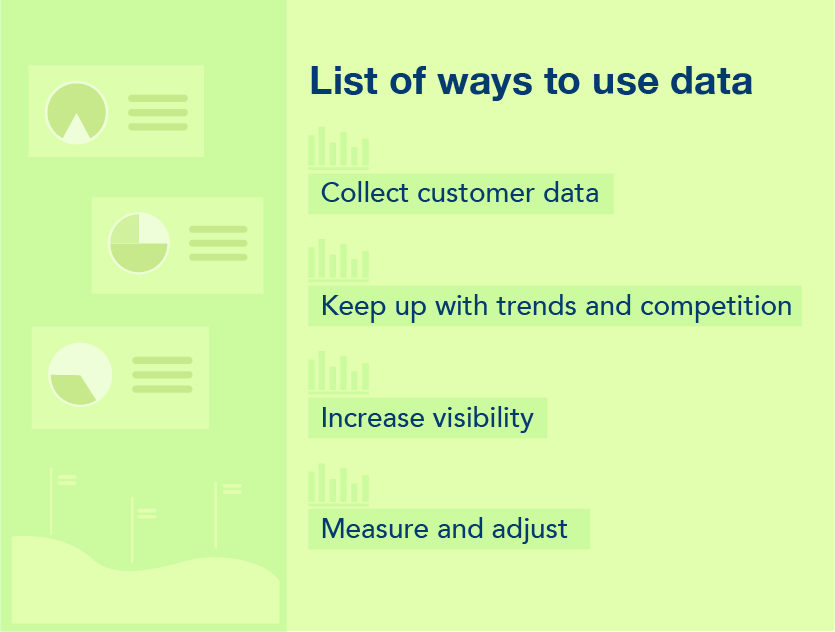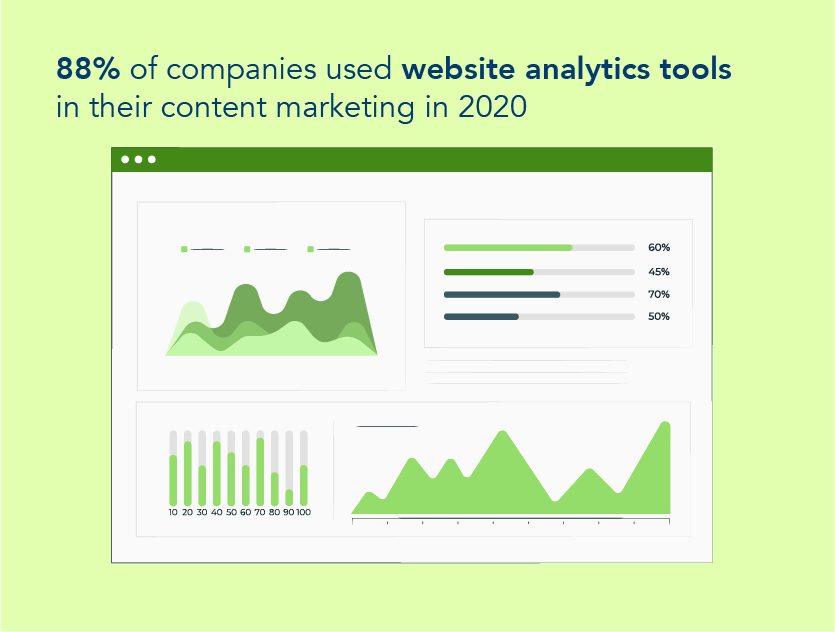

Data storytelling #1: Powering up your content with data

How do you appeal to people in a data-driven world? Use data to drive your content marketing.
It’s 2021, and more businesses are going online or developing an online presence. The world of online marketing is saturated. Companies need to use every tool they have to stand out from the crowd.
Why use data?
Data is useful in both the production and the pre and post-distribution of content marketing. It’s no wonder then that 88% of companies have used website analytics tools in their content marketing in 2020.
For one, data allows you to identify your audiences, the topics they are interested in as well as the social media channels that they prefer. With this information, you can now focus your resources on areas that matter the most.
Content creation can also be guided by the information gleaned from data. It can inform you of trending topics to create content about and the types of content and platforms best suited to your audience.
Using various metrics such as traffic, engagement rates and conversions, you can measure successes and spot weaknesses in your strategy.
With SEO and SEM tools, you can take steps to push your content further up the search rankings. The higher your ranking, the easier it is for you to be discovered and for you to be regarded as an authority on a certain topic.
How do you use data in content marketing?

Search engine optimisation (SEO) and search engine marketing (SEM) tools are aplenty. But how should you go about using them to beef up your content marketing?
Understand your audience
While most businesses already have an ideal target audience for their marketing, it always helps to conduct demographic profiling on your audience to better cater to them.
This is because collecting consumer data is key to understanding your audience and making improvements to your content marketing strategy.
Using tools like Google Analytics and Facebook Audience Insights (for marketing campaigns held on Facebook), you can obtain information such as age, gender, lifestyle and even the hobbies of your audience.
For us, we’ve used Google Analytics to identify the geographical locations of our primary audience, and we’ve found out that our key audiences are located in Singapore, Australia and the United States. This helps us funnel our content with topics that are most relevant to those regions.
It’s also important to listen to what your audience feels about your business. Using social listening tools, you can track your brand mentions on social media. This will give you insight into what people are saying about your brand and your content.
With all this information at hand, you can create buyer personas to better tailor your content to your target audience.
Keep up with trends and your competitors
Still unsure about what appeals to your audience? With social intelligence tools, you can identify trending topics around your target audience to inform your next content topic.
For example, with tools like SEMRush, you can explore millions of sub-ideas for a single keyword and look for those with the highest mentions. These are generally good indications of what topics people have been interested in recently.
It’s also important to scope out the competition. There are many analytics tools like Buzzsumo that allow you to find and analyse your competitors’ top performing content and publishing strategies.
By picking up some pointers from what your competitors are doing well in, you’ll be able to fine-tune your own content marketing campaigns.
Increase visibility
So you’ve created your content using the knowledge gleaned from data. But it doesn’t matter how appealing your content is if it doesn’t reach your audience in the first place.
Aside from using tools to identify trending keywords, you should also find low-competition keywords to use in your own content. This makes it easier for you to appear on the first search results page for that particular word.
That was how Fieldwire, a construction management platform managed to boost their content marketing. They created content based on keywords that had high traffic value and low ranking difficulty, identified using big data. As a result, they boosted their primary keywords to ranking in the top three positions.
Similarly, here at Click2View, we always run our blog posts through SEMRush’s SEO Writing Assistant. This plugin measures our SEO and even gives us recommended keywords to help enhance our visibility on search pages.
Of course, these keywords should be placed in high-attention areas such as in title tags, opening paragraphs and images to optimise search engine optimisation (SEO). But be careful to put the story and readability first, a jumble of SEO-friendly keywords strung together won’t win you any fans, probably quite the opposite.
Finally, you should make sure that you’re publishing your content at the right time. Social media analytics can be used to pin down the optimal posting times for social media.
For example, the optimal posting times for Instagram are during lunchtime, from 11am to 1pm, and evenings, from 7pm to 9pm.
Measure effectiveness and make adjustments
Data-driven content marketing doesn’t end after publishing. You should continue to track and analyse the performance of your content.
Using key performance indicators (KPI) informs you of how well your content marketing is doing. Some KPIs you should look at include interactions (such as comments and likes), time on page (how long people stay on your webpage) and conversion rates.
When you’re able to see what is performing well and what isn’t, you’ll be better able to prioritise your time and resources. You could also use A/B testing to further optimise and refine your content marketing.
Additionally, if you can find a common theme or pattern between the campaigns that have been doing well, then that might be what makes your audience click.
At Click2View, after looking at our data, we’ve realised that our video explainers have been doing well and bringing in lots of organic traction. To continue building on its success, we’ve been revisiting popular blog topics and turning them into video explainers.
Avoiding over-reliance
While data can be an extremely useful tool to boost your content marketing, you should still be wary of the pitfalls that come with being over-reliant on it.
Ultimately, data should be a complementary tool used to guide your content marketing strategy. Use it carefully, and don’t let it stifle your creativity.
Want to incorporate data into your content marketing? Get started by reaching out to our digital specialist Praveen at [email protected].
Read more from Click2View:
- Tap on the booming livestream e-commerce market.
- Extend your reach across countries and cultures with content marketing localisation.
- Capture the attention of your online audience with illustrations and animation
Sign up to our newsletter for a weekly update on the latest content marketing news. Don’t forget to subscribe to our YouTube channel too!
Click2View is Southeast Asia’s premiere full-service independent B2B content marketing agency servicing clients like Microsoft, Google, Visa, Prudential, and the Lee Kuan Yew School of Public Policy.









